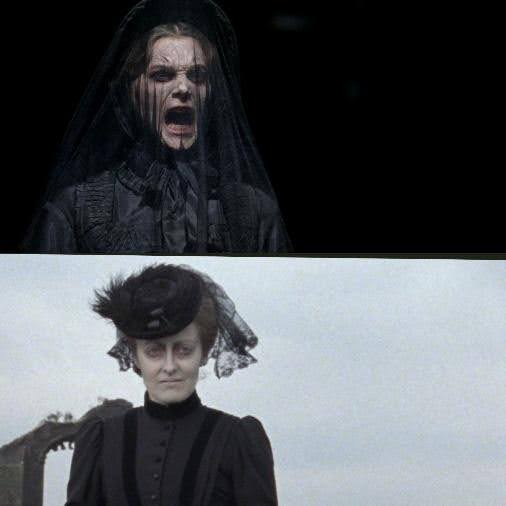Settling differences with Susan Hill’s horror
By Edward Bayliss
There’s a wonderful quotation I chanced upon recently in George Eliot’s Silas Marner – itself a novel so well informed by superstition and the supernatural. It goes: ‘Before such calm external beauty the presence of a vague fear is more distinctly felt – like a raven flapping its slow wing across the sunny air.’ It seems to me that this is the force that fills the sails of good horror. Like the small itch of a splinter between your toes, or in film terms, the almost imperceptible cant of a camera lens, there should exist an unease, barely there but present enough to unsettle you gradually. This is the agitated and wrinkled sheet on which the real time body horrors lie.
Susan Hill’s 1983 gothic horror novel, The Woman in Black, has borne two cinematic adaptations. Doubtless, most have heard of James Watkins’ 2012 version (starring Daniel Radcliffe), but I suspect Herbert Wise’s 1989 feature leans lonely against the shaded edge of our film shelves – even so, I must remember that I speak for a certain generation. In broad strokes, the films take markedly different approaches in their realisation of Hill’s novel on the screen. Wise’s Woman in Black is much more faithful to its source text, save his strange alteration of Arthur Kipps’ surname to ‘Kidd’, and the fashion of his family’s death; he leaves the meat of the original plot unspoiled. Watkins instead kills Kipps’ wife before the film has even begun, and donates much more of the film’s minutes to the circumstances of the children’s deaths in Crythin Gifford which are treated in more mysterious terms in Hill’s novel. Though I am very fond of the novel, I won’t pedestal it as some god-breathed scripture that must be followed to a T.
What interests me more are the directors’ treatment of that heap of a house – Eel Marsh House. We must consider not only the fact of the setting, but also the framing of the setting. The Drablow estate, set isolated across a marshy causeway suffocated by ‘sea threats’, is a great invention of horror. In Watkins’ 2012 adaptation, we see it first from high angle shots – it’s a black and brown tangle of trees and rocky outcrops, a kind of unspectacular Mont-Saint-Michel. It’s obscure and dark, very dark. The geography of the ‘island’ I’ve noticed doesn’t actually add up when we arrive at the house on ground level. Whether this is an intentional move from Watkins, I’m not sure. The estate grounds bear all the hallmarks of high gothic horror, with gnarled gravestones, trees antlered with dead branches appearing as grey phantoms, and carpets of smothering moss and ivy covering every unbreathing surface. A bluish grey filter sits on the lens throughout. The gothic catalogue is well read, maybe too well read.
Herbert Wise approaches the site with much more austerity, open space, and bigger skies. Eel Marsh House’s surroundings are unwooded, bare, and unsettlingly unfilled, except for the romantic ruin of a chapel arch which appears also on the cover of the first edition of Hill’s novel. This is the most notable difference in terms of the Eel Marsh grounds. To return to our initial assessment of ‘good horror’ prompted by the Eliot quotation, it’s the 1989 version that best exemplifies this undercurrent of edge. Let it be said, the scenery of the Drablow estate in Watkins’ film is uncomfortable, but it’s comfortably uncomfortable – for me it’s too explicit in its presentation, too direct. Its effects are overground, like a wind slapping against your cheek, whereas with Wise’s Woman in Black we feel more the unsteady shift of soil beneath our feet.
Now to the house itself. In the Radcliffe film, much like it’s outside, the inside of the house is in a state of complete disrepair (seemingly abandoned for decades), with Satis house-esque shivering cobwebs and burnt-down candlesticks. An infinitely long corridor on the first floor is unsurprisingly exploited in several POV push shots. The camera, I should say, behaves unsubtly in Watkins’ Eel Marsh House. It too often frames Radcliffe in the corner of the frame, demanding us to look elsewhere in the shot, and ‘shockingly’ discover the blurred shape of Jennet Humfrye, the woman in black, against a far away wall. The camera also appropriates the perspective of Humfrye too regularly so that the effect is rendered less and less potent in each instance. Here, the camera gymnastics often distract from the subject, creating a self-awareness, reminding us we are watching pixels on a screen in our sitting room.
There’s a theme here, if you hadn’t gathered. In Wise’s adaptation, the interior of Eel Marsh house is intact and lived in (Alice Drablow had only died a week prior to Kidds’ visit). There is even electricity, as in the novel, and few dark corners for phantoms to lurk. The electrical aspect of the house is used brilliantly. In an outhouse, a panting generator eerily sounds out through the house’s tight corridors. One of the most striking moments of the film occurs when the faulty generator is revived, and all the lights of the house are restored. In this exterior shot, the house again becomes uncannily alive. Wise’s film doesn’t rely on dark corners for the dark deeds of his woman in black. The lens, as though afraid, often shrinks back from the Jennet Humfrye rather than possess her.
Herbert Wise’s Woman in Black is the better of the two. For want of more coherent expression, it’s better to have uneasy easiness than easy uneasiness on the screen.
Image credits: IMDB & BFI

